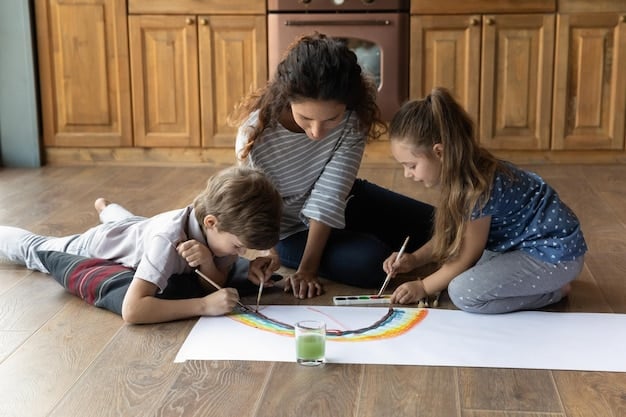Mindful Parenting: Deeper Connection with Your Kids

Conscious parenting involves intentional strategies to build stronger, more empathetic bonds with children, fostering their emotional well-being and enhancing family harmony through presence and active engagement.
In the whirlwind of modern life, deeply connecting with our children can feel like an elusive goal. Daily responsibilities, digital distractions, and the sheer pace of contemporary family life often pose challenges to fostering truly meaningful relationships. This article explores Mindful Parenting: 5 Strategies to Connect with Your Children on a Deeper Level, offering practical approaches to cultivate presence, understanding, and genuine connection within your family.
Understanding Mindful Parenting
Mindful parenting is more than just being present; it’s about being intentionally present, bringing a full, non-judgmental awareness to the parent-child relationship. It involves stepping back from automatic reactions and responding to situations with thoughtful consideration. This practice encourages parents to observe their own emotions and their children’s without immediate judgment, creating a space for deeper understanding and empathy.
In essence, mindful parenting is about cultivating a state of awareness that allows parents to pause, reflect, and choose their responses rather than simply reacting out of habit, stress, or conditioning. This approach fosters a more harmonious and respectful environment for both parents and children.
The Core Principles
Mindful parenting rests on several foundational principles designed to enhance genuine connection and emotional regulation. These aren’t just abstract ideas but actionable practices that can transform daily interactions.
- Presence: Fully engaging in the moment with your child, without distraction from internal thoughts or external devices. This means being truly there, listening and observing.
- Non-Judgment: Observing your child’s behavior and your own reactions without immediate evaluation or criticism. It’s about accepting what is, learning from it, and moving forward.
- Self-Compassion: Extending kindness and understanding to oneself, especially during challenging parenting moments. Recognizing that parenting is an imperfect journey and mistakes are part of the learning process.
- Empathy: Attempting to understand and share the feelings of your child, seeing the world from their perspective. This deepens connection and allows for more appropriate responses.
These principles work in concert, creating a framework where interactions are less about control and more about collaboration and mutual respect. They help parents navigate the complexities of raising children with greater calm and intention.

Mindful parenting isn’t a quick fix, but a journey of continuous learning and adaptation. It demands patience and a willingness to look inward, understanding that external reactions often stem from internal states. By mastering these principles, parents can unlock a more peaceful and fulfilling family life, where connections are built on a foundation of authentic understanding and mutual respect. It shifts the focus from managing behavior to nurturing relationships, leading to more resilient and emotionally intelligent children.
Ultimately, embracing mindful parenting empowers families to navigate challenges with greater ease, fostering an environment where every member feels seen, heard, and valued. It’s about creating a legacy of emotional intelligence and strong, loving bonds.
Strategy 1: Cultivating Presence and Active Listening
One of the most powerful tools in the mindful parenting toolbox is the cultivation of true presence and active listening. In a world brimming with distractions, giving our children our undivided attention can feel like a rare commodity. Yet, it is precisely this focused presence that deepens connection and makes children feel truly seen and heard.
Being present means more than just being in the same room. It means putting away your phone, turning off the TV, and genuinely tuning into what your child is saying, both verbally and non-verbally. This kind of attention communicates unconditional love and respect, building a foundation of trust that is invaluable for their emotional development.
The Art of Deep Listening
Active listening goes beyond merely hearing words; it involves understanding the underlying emotions and needs your child is expressing. This requires a conscious effort to absorb their message without immediately formulating a response or jumping to conclusions.
- Mirroring: Reflecting back what your child said, in your own words, to ensure you understood correctly. For example, “So, it sounds like you’re really frustrated because your friend didn’t share the toy today?”
- Empathizing: Acknowledging and validating their feelings, even if you don’t agree with their perspective or behavior. “I can see why that would make you feel sad.”
- Open-Ended Questions: Encouraging them to elaborate by asking questions that require more than a yes/no answer. “What happened next?” or “How did that make you feel inside?”
These techniques show your child that you are engaged and genuinely interested in their world. They learn that their thoughts and feelings are important, which in turn fosters their self-esteem and willingness to communicate openly.
When you actively listen, you’re not just gathering information; you’re creating a safe space for your child to express themselves without fear of judgment. This practice can reveal insights into their inner world that might otherwise remain hidden. It helps you understand their motivators, anxieties, and joys, allowing you to respond with greater wisdom and compassion.
Furthermore, active listening models effective communication for your children. They learn by observing your efforts to understand them, and this skill will serve them well in all their relationships throughout life. By making a conscious effort to be present and actively listen, parents transform everyday interactions into moments of profound connection and mutual growth.
This strategy is about making intentional choices to prioritize human connection over distractions, demonstrating to your children that they are your most valuable asset. The moments of shared presence, however brief, contribute significantly to a child’s sense of security and belonging, fostering a strong and resilient parent-child bond.
Strategy 2: Fostering Emotional Intelligence (Both Yours and Theirs)
Mindful parenting deeply intertwines with the development of emotional intelligence, for both parent and child. It’s about recognizing, understanding, and managing emotions effectively. This isn’t just about controlling outbursts, but about building a rich inner life that allows for resilience, empathy, and healthy relationships.
Many parents focus on behavioral outcomes, but mindful parenting encourages a deeper dive into the emotional roots of behavior. By understanding why a child is acting a certain way, parents can respond with greater insight and teach valuable emotional regulation skills. This begins with parents becoming attuned to their own emotional landscape.
Developing Self-Awareness and Co-regulation
Before parents can teach their children about emotions, they must first understand their own. This involves observing your own triggers, reactions, and underlying feelings without judgment. When parents are aware of their emotional state, they are better equipped to respond calmly and mindfully to their children’s emotional challenges.
- Naming Emotions: Helping children identify and name their feelings. “It looks like you’re feeling really angry right now.” This simple act helps children understand and process their internal experiences.
- Validating Feelings: Letting children know that their emotions are acceptable and understandable, even if their behavior isn’t. “It’s okay to feel sad about that, and I’m here to listen.”
- Teaching Coping Strategies: Guiding children through healthy ways to express and manage difficult emotions, such as deep breathing, drawing, or talking about it.
Co-regulation is a critical aspect, where parents help their children regulate intense emotions by remaining calm themselves. This provides a supportive external framework until the child develops their own internal regulatory capabilities.
By fostering emotional intelligence, parents equip their children with essential life skills that extend far beyond the family unit. Children who understand their emotions are better able to navigate social situations, build strong friendships, and cope with life’s inevitable ups and downs. They learn that all emotions are valid, but that there are constructive ways to express them.
This strategy also involves parents modeling emotional intelligence. When parents demonstrate healthy ways of dealing with their own stress, anger, or sadness, children learn by example. They see that it’s possible to feel strong emotions without being overwhelmed by them. This cultivates a family environment where emotional expression is encouraged and managed constructively, leading to deeper understanding and connection within the family system.
Investing in emotional intelligence is an investment in your child’s long-term well-being and resilience. It moves beyond merely telling children what to do, to helping them understand who they are and how to navigate their inner world with skill and compassion.
Strategy 3: Practicing Compassion and Empathy
At the heart of mindful parenting lies the powerful tandem of compassion and empathy. These qualities are not just feelings; they are active choices and practices that build bridges of understanding between parents and children. When parents approach their children with genuine compassion and strive to understand their perspective through empathy, the depth of their connection grows exponentially.
Compassion involves feeling concern and kindness towards someone, especially when they are suffering. Empathy, on the other hand, is the ability to understand and share the feelings of another. Together, they create a parenting approach that is rooted in love, understanding, and a desire to alleviate distress rather than merely correct behavior.
Walking in Their Shoes
To truly practice empathy, parents must make a conscious effort to see the world through their child’s eyes. This means suspending adult judgments and remembering what it was like to be small, to have big feelings about seemingly small things, and to navigate a world that often feels overwhelmingly large.
- Perspective-Taking: Asking yourself, “Why might my child be feeling or acting this way right now?” Consider their age, developmental stage, recent experiences, and temperament.
- Validating Feelings: Even if you don’t agree with their actions, acknowledging their feelings. For example, “I can see you’re really upset that you can’t have another cookie. It’s tough when you want something and can’t have it.”
- Responding with Kindness: Choosing to respond with a gentle tone, a comforting touch, or a reassuring gaze, especially when your child is struggling. This reinforces that you are a safe haven.
Empathy isn’t about condoning misbehavior, but about understanding the underlying need or emotion driving it. Once understood, it becomes easier to guide children towards more constructive ways of coping.
Practicing self-compassion is equally vital for parents. Parenting is incredibly challenging, and there will be moments of frustration, anger, or fatigue. Extending the same understanding and kindness to yourself that you offer your child is crucial for sustainable mindful parenting. Recognizing that you are doing your best, even when you make mistakes, allows you to reset and approach the next moment with renewed patience.
When children experience consistent compassion and empathy from their parents, they learn to be compassionate and empathetic themselves. They internalize the message that their feelings matter and that they are worthy of understanding and love. This foundational learning shapes their interactions with peers, family members, and eventually their own children, propagating a cycle of kindness.
This strategy transforms disciplinary moments into teaching moments, where children learn about boundaries within a framework of love and understanding. It moves beyond superficial compliance to genuine internalization of values, fostering connections built on mutual respect and profound emotional safety.
Strategy 4: Setting Mindful Boundaries and Expectations
Mindful parenting is not about a lack of discipline; rather, it’s about setting boundaries and expectations with intention, awareness, and kindness. This approach recognizes that limits are essential for a child’s safety, development, and sense of security, but they should be established and enforced in a way that respects the child’s individuality and fosters autonomy.
Instead of rigid rules enforced through fear, mindful boundaries are communicated clearly, consistently, and often collaboratively. They teach children about consequences and personal responsibility within a loving and supportive framework. This method helps children internalize guidelines, rather than merely complying out of obligation.
Clear Communication and Natural Consequences
Effective mindful boundaries are characterized by clarity and a focus on natural or logical consequences. This helps children understand the “why” behind the rules, promoting genuine learning over rote obedience.
- Clarity and Consistency: State boundaries simply and ensure all caregivers enforce them consistently. “We don’t hit others because it hurts them.”
- Age-Appropriateness: Ensure expectations match your child’s developmental stage. A toddler cannot regulate impulses like an older child.
- Explaining the “Why”: Help children understand the reason behind a boundary. “We need to clean up toys so no one trips and gets hurt.”
- Natural/Logical Consequences: Allow natural consequences to unfold or implement logical ones where appropriate. If toys aren’t put away, they might not be available for play later.
This approach moves away from punitive measures and towards guidance, helping children develop self-control and problem-solving skills. It empowers them to make responsible choices by understanding the direct impact of their actions.

Mindful boundary setting also involves parents being mindful of their own emotional state when enforcing limits. Approaching discipline from a place of calm and rationale, rather than anger or frustration, helps maintain the connection and models emotional regulation for the child. It’s about being firm but kind, holding boundaries with compassion.
Furthermore, involving children in the discussion of rules and consequences, when age-appropriate, can significantly increase their buy-in and understanding. This collaborative approach fosters a sense of agency and respect, allowing children to feel like active participants in their family’s structure rather than passive recipients of rules.
By establishing mindful boundaries, parents provide a secure framework within which children can explore, learn, and grow safely. It cultivates an environment where children feel secure, understand expectations, and develop the internal compass necessary to navigate their world responsibly, deepening the parent-child bond through trust and mutual respect.
Strategy 5: Engaging in Play and Shared Experiences Mindfully
One of the most joyful and effective ways to connect with children on a deeper level is through mindful play and shared experiences. Play is the language of childhood, and when parents engage in it with full presence and appreciation, it becomes a powerful vehicle for connection, learning, and emotional bonding. These moments are not just about entertainment; they are rich opportunities to understand your child’s unique personality, creativity, and inner world.
Mindful play means stepping into your child’s imaginative world, letting go of adult agendas, and simply enjoying the moment together. It’s about following their lead, being curious about their ideas, and truly relishing the shared activity. This kind of engagement sends a clear message: “I value you, your interests, and our time together.”
Presence in Play and Exploration
To engage mindfully in play and shared experiences, parents need to bring their full attention and enthusiasm to the activity. This means minimizing distractions and focusing solely on the interaction with their child.
- Child-Led Play: Allow your child to direct the play. Resist the urge to correct, instruct, or impose your own ideas. Simply participate as a supportive and enthusiastic companion.
- Observation and Curiosity: Pay attention to how your child plays, what excites them, and what challenges them. Ask open-ended questions about their imaginative worlds.
- Shared Laughter and Joy: Embrace moments of pure fun and laughter. These shared positive emotions release oxytocin, the “bonding hormone,” strengthening your connection.
- Being Fully Present: Put away phones, turn off background noise, and give your child your undivided attention during playtime. Even short bursts of focused, mindful play are incredibly valuable.
These dedicated moments of play create a reservoir of positive memories and strengthen the emotional bond. They are opportunities for children to feel understood, celebrated, and loved for exactly who they are.
Beyond structured play, mindful engagement extends to shared daily experiences, whether it’s cooking together, going for a walk, or reading a story. These seemingly mundane activities become extraordinary when approached with presence and intention. It’s about paying attention to the small details, the shared glances, and the quiet moments of togetherness that often get overlooked in the hustle and bustle of life.
When parents consistently engage in mindful play and shared experiences, children learn that they are worthy of their parents’ time and attention. This builds their self-esteem and fosters a sense of security. It also provides a creative outlet for emotions and helps children develop critical social, emotional, and cognitive skills in a natural, enjoyable way. The magic of these moments lies in their simplicity and the profound connection they forge, making the parent-child relationship a source of deep joy and mutual growth.
Integrating Mindful Parenting into Daily Life
The concept of mindful parenting might seem overwhelming, suggesting a complete overhaul of your current approach. However, it’s not about being perfect, but about weaving small, intentional moments of mindfulness into the fabric of your everyday life. Integrating these practices gradually can lead to profound shifts in your family dynamics and personal well-being.
Start small, perhaps by choosing one strategy to focus on each week, or dedicating just five minutes a day to a specific mindful practice. The goal is to build resilience and connection, not to achieve an unattainable ideal. It’s about progress, not perfection.
Small Shifts, Big Impact
Making mindful choices throughout the day can significantly enhance your connection with your children without requiring grand gestures or extensive time commitments.
- Mindful Mornings: Instead of rushing, take a few extra minutes to make eye contact, offer a genuine hug, or share a calm, brief conversation before the day begins.
- Transitional Moments: Be present during transitions, like picking up children from school or coming home from work. Instead of immediately asking “How was your day?”, try a warm greeting and wait for them to share when ready.
- Mealtime Connection: Turn off screens and engage in conversation during meals. These can be prime opportunities for sharing, listening, and bonding.
- Bedtime Rituals: Use bedtime as a time for calm, reflective connection through reading, quiet talks, or reviewing the day’s highlights.
These moments, often overlooked, are rich with opportunities for mindful interaction and connection. They accumulate over time to create a strong, loving foundation.
Self-care for parents is also an undeniable aspect of successful mindful parenting. You cannot pour from an empty cup. Taking time to recharge, practice your own mindfulness, or engage in activities that bring you joy enables you to show up as a more patient, present, and compassionate parent. Recognizing your own needs is not selfish; it is essential for sustaining your capacity for mindful engagement.
The journey of integrating mindful parenting is continuous, filled with learning, adaptation, and growth for both parents and children. It acknowledges that setbacks will happen, but it encourages a gentle return to present awareness. By embracing these principles, families can create an environment where connection thrives, misunderstandings are addressed with empathy, and every day offers new opportunities for genuine, heartfelt relationships. It’s a purposeful way of living that elevates the ordinary into the extraordinary, fostering deep and lasting bonds.
| Key Strategy | Brief Description |
|---|---|
| ✨ Cultivating Presence | Engage fully with your child, listen actively, and be truly present in the moment. |
| 🧠 Foster Emotional Intelligence | Help children identify and manage emotions, while also practicing self-awareness. |
| ❤️ Practice Compassion & Empathy | Understand and share your child’s feelings, responding with kindness and understanding. |
| 🧩 Mindful Play & Shared Experiences | Engage joyfully in child-led play, creating positive, shared memories and bonds. |
Frequently Asked Questions About Mindful Parenting
The primary goal of mindful parenting is to foster a deeper, more empathetic, and authentic connection between parents and children. It aims to develop conscious awareness, helping parents respond thoughtfully rather than reactively, leading to stronger bonds and a more harmonious family environment.
Mindful parenting emphasizes intentional presence, emotional regulation, and non-judgment, focusing on the quality of the relationship and emotional well-being. Traditional parenting often prioritizes discipline, obedience, and external behavioral outcomes, which can sometimes overlook the underlying emotional needs of the child.
Yes, absolutely. By understanding the emotional roots of behavior and responding with empathy and clear, consistent boundaries, mindful parenting equips parents to address challenging behaviors more effectively. It shifts the focus from punishment to teaching, helping children develop self-regulation and problem-solving skills.
Mindful parenting doesn’t require endless hours; it’s about intentionality in short, quality moments. Even five minutes of undivided attention, active listening, or a mindful shared activity can significantly strengthen your connection. Integrating small acts of presence into daily routines can make a big difference.
Self-compassion is crucial. Parenting is demanding, and mistakes are inevitable. By extending kindness and understanding to yourself during difficult moments, you recharge your emotional reserves and model resilience for your children. It allows you to return to a mindful approach with greater patience and less self-criticism.
Conclusion
Mindful Parenting: 5 Strategies to Connect with Your Children on a Deeper Level offers a profound pathway to enriching family life. By embracing presence, fostering emotional intelligence, practicing compassion, setting mindful boundaries, and engaging in purposeful play, parents can cultivate relationships built on trust, understanding, and genuine affection. This journey is not about perfection, but about consistent, intentional effort to be fully present and responsive to the unique needs of each child. The deep connections forged through mindful parenting lay a resilient foundation for children’s emotional well-being and a more harmonious home environment for everyone.





